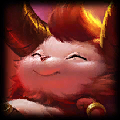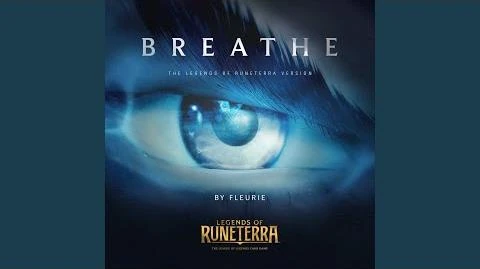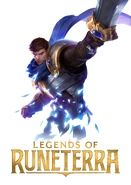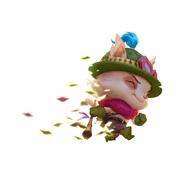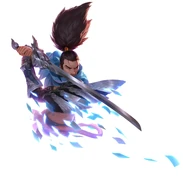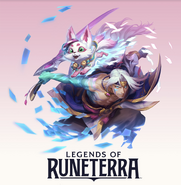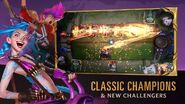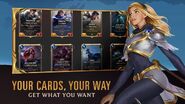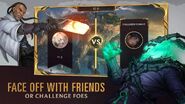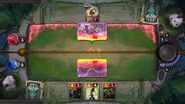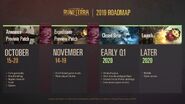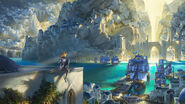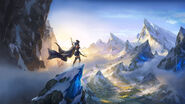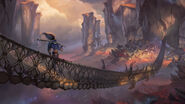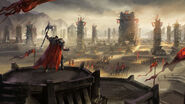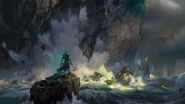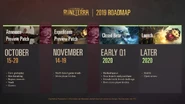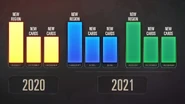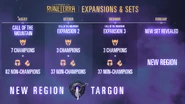![]() Legends of Runeterra (or LoR) is a card game developed by
Legends of Runeterra (or LoR) is a card game developed by ![]() Riot Games (development name was Project B). The game was first announced by Riot Games, and entered its first closed beta, on October 15th 2019, coinciding with the 10th Anniversary of
Riot Games (development name was Project B). The game was first announced by Riot Games, and entered its first closed beta, on October 15th 2019, coinciding with the 10th Anniversary of ![]() League of Legends, and then was released permanently but still in open beta after being announced during the lead up to Season Ten's start on 24th January 2020. It was released in full on April 30th 2020.[4]
League of Legends, and then was released permanently but still in open beta after being announced during the lead up to Season Ten's start on 24th January 2020. It was released in full on April 30th 2020.[4]
Description[]
Set in the world of League of Legends, Legends of Runeterra is the strategy card game where skill, creativity, and cleverness determine success. Choose champions and combine cards from different regions, each with their own style and strategic advantage, then build the perfect deck to take down the rest. Classic champs from League of Legends and brand new characters from the world of ![]() Runeterra come to life in vivid detail.
Runeterra come to life in vivid detail.
The game itself is all about the choices made and the risks taken. Every move matters and the outplays are all up to the players. Players can earn cards for free as they play or buy exactly what they want in the store, they're in control of their collection, and never pay for random packs of cards. Players combine, adapt, and experiment with frequent new releases in an always-evolving meta. Dynamic, alternating gameplay means players can always react and counter, but so can the opponent. Players can battle friends for bragging rights, challenge foes in Ranked play, or embark on an Expedition and draft a deck. Players can explore the epic regions of Runeterra to reveal hidden connections between the denizens, dangers, and creatures that live there. In Legends of Runeterra, players choose from dozens of champion cards to include in their deck, each with a unique mechanic inspired by their original League of Legends abilities.
Champions enter the battle as powerful cards, and if played in a smart way, they level up to become even more epic, by gaining new abilities to crush the opponent. They can turn the tide of battle with a swift combo, or even break the rules and claim a new way to win. Champions are key cards to build your deck around, but to take down the enemy Nexus, multiple unique units are required. Allies that support a champion's strategy to level up fast and take control of the board are wise picks. There are tons of supporting cards to choose, from some familiar faces or completely new ones.
Every character and card in the game comes from a region of ![]() Runeterra. Players have access to cards from ten major regions:
Runeterra. Players have access to cards from ten major regions: ![]() Bandle City,
Bandle City, ![]() Bilgewater,
Bilgewater, ![]() Demacia,
Demacia, ![]() Freljord,
Freljord, ![]() Noxus,
Noxus, ![]() Piltover & Zaun,
Piltover & Zaun, ![]() Ionia,
Ionia, ![]() Shadow Isles,
Shadow Isles, ![]() Shurima and
Shurima and ![]() Targon. Each region has a distinct playstyle and strategic advantage, but things get even more interesting when you combine cards from two different regions. There's a deck for every personality and playstyle, but it's up to the player to find the right cards for a winning strategy.
Targon. Each region has a distinct playstyle and strategic advantage, but things get even more interesting when you combine cards from two different regions. There's a deck for every personality and playstyle, but it's up to the player to find the right cards for a winning strategy.
Legends of Runeterra is free to play. Victory or defeat, each battle brings experience and progress. Choose which region to explore first and unlock the interesting cards from that region, changing regions whenever. As players advance, they'll collect new allies, spells, and champions; more than enough for multiple decks.
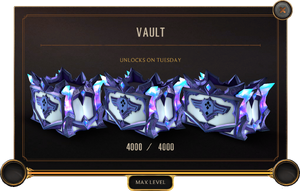
A level 13 vault, with 3 diamond chests as the rewards.
Once a week, players will also unlock chests from the Vault. These chests level up with more play, up to a maximum of level 13, increasing the rarity of cards inside from common all the way up to champion. They can also contain wildcards, which can be turned into any card, no guessing required. Experiment with an abundance of new cards to discover unique playstyles and craft innovative strategy. As a collection grows, so does its possibilities.
Gameplay[]
- The game consists of matches between two players using decks of cards.
- A match is played out on The Board, this games field of battle.
Rounds[]
- Players play in rounds, one player is on attack and the other is on defense. The player on attack gets an
 Attack Token for free, and gets the
Attack Token for free, and gets the  Play Order Token. The player on attack during round 1 is random.
Play Order Token. The player on attack during round 1 is random. - In a round, players draw a card, then take turns starting with the player on attack. A player can play cards during their turn, or pass. If both players pass without acting, the rounds end.
- All cards have a mana cost, and are unplayable unless a player has enough available mana to use the card. Spells have access to a special pool of mana called "Spell Mana". Unused mana at the end of the turn will be converted into spell mana, up to a max of 3. Spells use spell mana before using normal mana.
 Spell cards have 4 "speeds",
Spell cards have 4 "speeds",  Slow,
Slow, Fast,
 Focus and
Focus and Burst.
- Slow spells can not be played during combat or in response to an another spell. After played, a spell stack starts and the opponent gets a chance to respond to the spell, and perhaps even prevent it.
- Fast spells can be played at anytime during a player's turn, the opponent gets a chance to respond to the spell, and perhaps even prevent it.
- Burst spells can be played at anytime during a player's turn, and do not end the turn. The opponent does get to respond to the spell, but only after the effects of it have been resolved.
- Focus spells can only be played when no player is in combat or when not in response to another spell. They are cast instantly like burst and will not end the turn. Only after the effects resolved will the opponent respond.
- When playing a Unit card, either a
 Follower or
Follower or  Champion, the unit is moved from the hand to the bench. When playing a
Champion, the unit is moved from the hand to the bench. When playing a  Landmark, this card will also moved from the hand to the bench.
Landmark, this card will also moved from the hand to the bench. - Players can move units from bench to battlefield, and once a player with the Token has units on the battlefield, they trigger an
Attack, giving the enemy a turn to plan their defense. Players can't move Landmarks from bench to battlefield.
- If a player does not have strong enough units to defend themselves, their

 Nexus health will be reduced.
Nexus health will be reduced. - The player that can reduce the enemy nexus health to zero, or achieve a winning condition from their cards, win the game. If their opponent cannot draw because his or her deck is empty, the player also win the game.
- Players can only have 10 cards in hand, 6 units on the bench, 6 units on the battlefield. Cards that exceed this limit will be
 Obliterated.
Obliterated. - Players can only have 40 cards in their deck, of which 6 can be champion cards. All cards have a max limit of 3 copies per deck.
- If the game reaches round 40, the game will end in a tie. If both nexus are destroyed and/or win conditions are completed and/or cannot draw because his or her deck is empty at the same time, the game will also end in a tie.
- Players can also play expeditions to gain additional chests and unlocks quicker.
Cards[]
Region Types[]
- Main article: Regions (Legends of Runeterra)
Currently, these are all the regions in the game:
Along with these, an eleventh, ![]() Regionless 'Runeterra' card set exists with its own set of mechanics.
Regionless 'Runeterra' card set exists with its own set of mechanics.
Card Types[]
- Main article: Card types (Legends of Runeterra)
- Main article: List of cards (Legends of Runeterra)
There are three types of cards, Unit, Landmark and Spell cards. Each of them have their own card sub-types.
A unit cards have 3 standard value.
 Power, in orange, shows how much damage a unit can deal in battle.
Power, in orange, shows how much damage a unit can deal in battle. Health, in red, shows how much damage a unit can take before defeated.
Health, in red, shows how much damage a unit can take before defeated.- Subtype. There are two Subtype of Unit cards:
Champions card are special cards a player own. A player can own multiple champion cards, however, when one champion is active, the duplicate cards will transform into special spells, similar to the ones existing, with a unique action: Shuffle a copy of the champion card into the player deck.
Champions can ![]() level up, by fulfilling their level up requirements. Level up usually gives the champion card better stats and better abilities.
level up, by fulfilling their level up requirements. Level up usually gives the champion card better stats and better abilities.
Spells triggers an instant effect in the game. Based on the type of spell, the effect may trigger immediately, or be resolved in a spell stack.
Landmarks are not units, which they have no power or health, and can't be used on combat. They do take up one space upon your board and has powerful abilities that can shake the game. Some landmarks has Round Start abilities while other landmarks will be destroyed and activate once their Countdown reaches 0.
Terminology[]
- Main article: Terminology (Legends of Runeterra)Legends of Runeterra has its own share of keywords and terminologies used in and outside of the game, with some terms being used to simplify and facilitate rapid communication.
Trivia[]
- Legends of Runeterra is Riot Games' take on the Digital collectible card game genre.
- Riot stated that every card's description is considered canon in the main universe. However, some characters' interactions are only hypothetical should they ever meet someone or see something in certain situations.[5] There are also some visuals that should not be considered canon such as pre-update .
- With the release of the 2020 K/DA Event, several K/DA related cards have been released. These and their descriptions are not considered canon but part of the
 Music skins universe.
Music skins universe.
- With the release of the 2020 K/DA Event, several K/DA related cards have been released. These and their descriptions are not considered canon but part of the
- Main article: List of cards (Legends of Runeterra)/Alternate
- In some regions, such as China and Korea, Legends of Runeterra cards are censored due to cultural and legal reasons. Changes range from color changes (
 red to
red to  purple), to removing depictions of
purple), to removing depictions of  red blood (usually with something that is
red blood (usually with something that is  purple), to replacing
purple), to replacing  skull-like or skeleton appearances with a
skull-like or skeleton appearances with a  helmet (or less human skull like depiction), to replacing facial hair, to adding more
helmet (or less human skull like depiction), to replacing facial hair, to adding more 
 clothing to characters, and to outright removing characters
clothing to characters, and to outright removing characters 
 from card art. These changes also effect their regional League Displays.
from card art. These changes also effect their regional League Displays.
Media[]
- Related Videos
See Also[]
